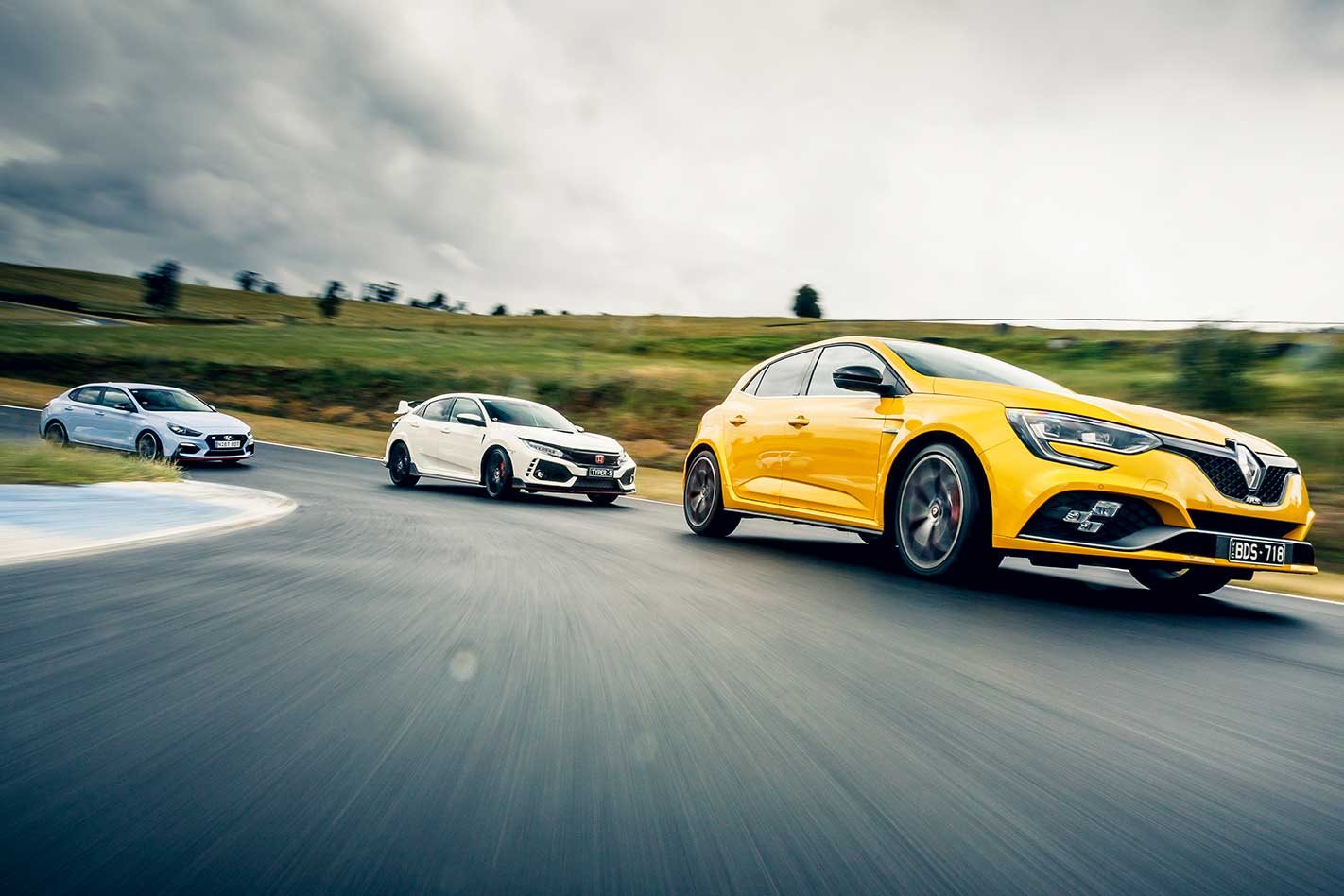YES, WE KNOW, this looks familiar. It was just over a year ago that we assembled the finest front-drivers going and unleashed them on the fresh, third-generation Renault Megane RS. When all was said and done, the Honda Civic Type R bowled over its opponents, including the plucky Frenchie. So that turns this comparison into a foregone conclusion, right? Not quite.
Dieppe has been slowly turning up the heat on its Megane RS and has finally revealed its ultimate forms. One take is the no-holds-barred, Nürburgring record-chaser (and holder) RS Trophy-R that we had along at Performance Car of The Year 2020. We would have loved to see the lightweight, carbonfibre-clad warrior take on Honda after dethroning it as the fastest front-drive car at the ’Ring, but the Trophy-R’s astronomical price ($74,990) unbalances the match-up.

That’s fine because that mega-Megane shares some DNA with the less potent RS Trophy 300 EDC we have here. Sure, it looks as if it has only gained some new alloys, but under the bulging bodywork, Renault Sport’s crew has tweaked its arsenal for a more involving, heart-thumping drive. That 1.8-litre engine, for instance, gets the ceramic ball-bearing turbocharger from the Trophy-R, so it’s good for 221kW. And that six-speed dual-clutch transmission, or Efficient Dual Clutch (EDC), isn’t held back by the manual’s torque limit, so you get the full 420Nm, or 20Nm more than any other Megane.
Underpinning the Trophy is Renault’s Megane Cup chassis, bumping up the spring, damper and anti-roll bar stiffness rates to match broad Bridgestone rubber at each corner. Oh, and a Torsen LSD sits between its fancy dual-axis front hubs.
While we’re here, it’s worth mentioning that Renault Australia sadly doesn’t offer the optional Trophy lightweight 19s and higher-grip Bridgestone S007 tyres like other markets do, so it comes with regular S001 tyres.
Renault’s 4Control rear-steering system persists at the back, while there’s a pair of new slotted brake discs that shed 1.8kg per corner on the front-end.
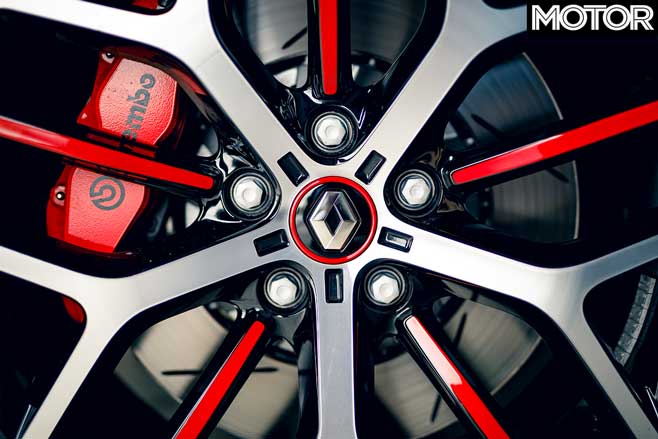
Climbing aboard, the driver’s pew has dropped 20mm – enhancing the ergonomics when matched with the EDC’s twin-pedal setup. Again, it hurts that we miss out on the optional Recaro buckets available overseas, as they’re achingly gorgeous, but the deep standard seats mean you’re still front row to hear the Trophy’s new electronically controlled exhaust.
On top of that, the Trophy adds Bose audio, and a lightweight lithium battery to help cancel out the amp and subwoofer’s extra weight, while Alcantara wraps the steering wheel and seats. All up this tacks $4000 onto the price of a Megane RS Cup manual or EDC variant, so you’re looking at $55,900 for Trophy EDC before on-roads. And that might make our next contestant look unusually cheap.
Honda originally injected the Civic Type R into the market with one specification and only released a range of optional accessories since – including a $14K set of forged wheels – and today the only true factory option for the Honda continues to be pearlescent paint. That’s fine, since it has been a winning formula so far in standard trim.
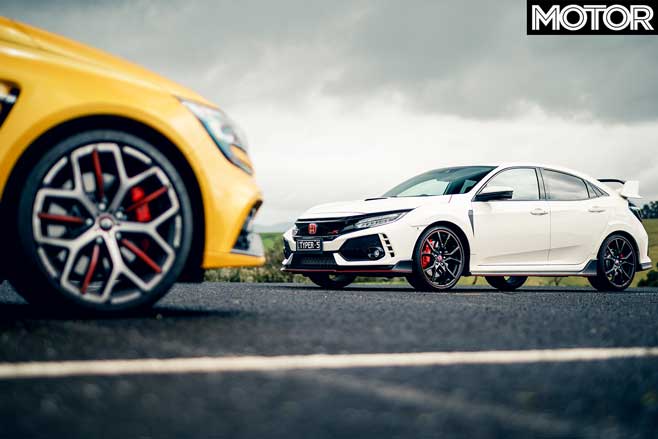
Up front is the same 2.0-litre turbo four, mated to a six-speed manual gearbox, that produces 228kW and 400Nm, which is in the same ballpark as the Renault. But the two share more than just similar outputs.
Honda slots between its front axles a helical LSD that, like a Torsen, relies on a set of mechanical gears to transfer torque between the front tyres (which measure the same 245mm as the Renault). Dual-axis front hubs feature as well. They split steering and suspension duties across two separate systems within the front knuckle design. Inside, the interior remains unchanged and there are still only four seatbelts. As far as price goes, the Honda undercuts the Renault at $51,990 plus on-roads. But it’s still nowhere as value-focused as our third contender.
We’ve met the Hyundai i30 Fastback N before. The sleek-bodied version of the popular hatch landed early last year to diversify the N range while Hyundai toils away on the long-promised dual-clutch variant. But this is not just an i30 N in a new tracksuit.
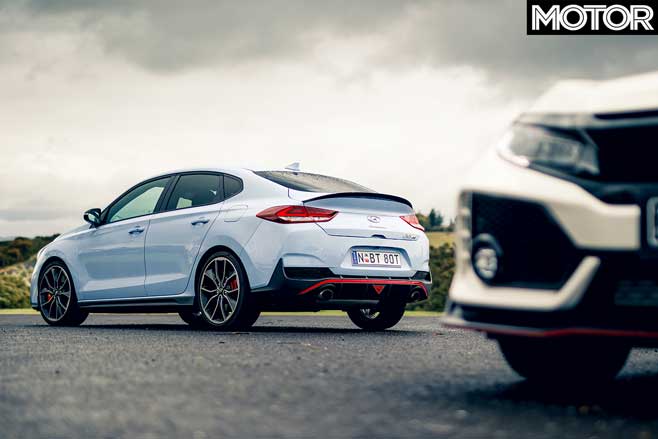
The engineers in Seoul changed a few things to wrought the i30 N into its Fastback shape. The ducktail extends the boot 120mm, and they also spot-weld its body an extra 29 times to retain handling crispness. The softer front suspension features new helper springs and stiffer mounts, while tubular rear camber arms promise more consistent alignment settings when you’re bouncing off kerbs.
Other than that, the 2.0-litre turbo four uses the same 202kW and 353Nm (378Nm briefly on overboost) to shift the Fastback’s extra 12kg over the hatch. It also includes the i30 N’s regular weapons – a six-speed manual, electronically controlled LSD, adaptive dampers, beefier brakes and a sport-tuned ESP.
This amounts to a modest $1500 price increase on the hatch, pegging the Fastback N at $41,990 before options and on-roads. Our test car also comes with the Luxury Pack option, which adds a fair bit to its equipment list, and $3000 to the bill, for a total as-tested price of $44,990.
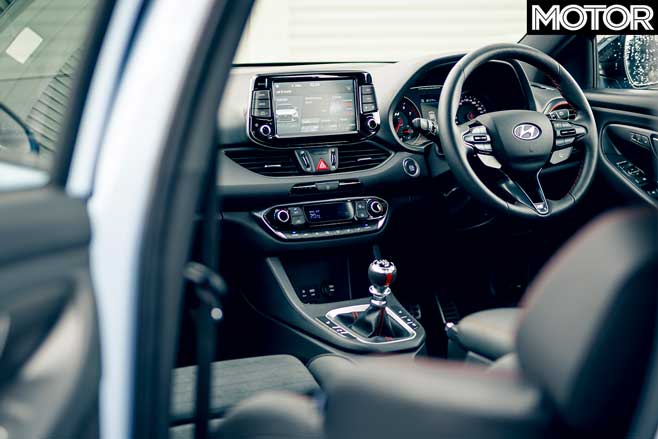
While the Hyundai comes in at a much lower price point, this actually helps it at the drag strip since it’s the sole car here with a traditional handbrake lever. Loading up the handbrake with some revs on helps spool the turbo when launching from a standstill. The added resistance also pulls the comparatively skinny Pirellis into the tarmac for more grip, so with a bit of luck you’ll avoid waking the undefeatable traction control.
Rowing through its gearbox reveals a direct and free shift action, but the upshift into third at 98km/h prevents the Hyundai recording a sub-six 0-100km/h time. Beyond that, the Hyundai needs every Newton-metre to keep its mass hustling down the chute. It carries a decent 162.51km/h across the end line and stops the watch at 14.28sec but doesn’t feel particularly fast – even though times like these would munch late-’90s muscle cars.
No handbrake tricks lie in the Honda’s arsenal since moving to an electric version, so launching it effectively requires balancing revs with unavoidable wheelspin. And of that there is much. The K20C1 VTEC unit piles on torque ferociously as the revs charge towards its 7000rpm redline, which can make timing the shifts particularly hard.
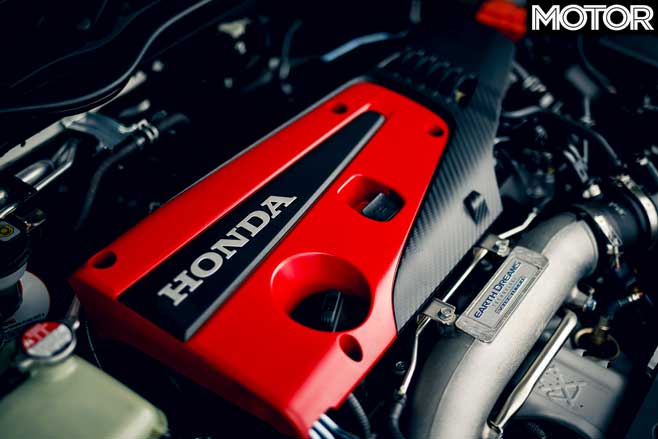
Execute them right – especially from second to third gear, where some crucial momentum might carry you past 100km/h – and you’ll extract good times. After plenty of launches we managed 0-100km/h in 5.81sec before crossing the finish in 13.77sec almost 10km/h faster the Hyundai. You can thank the Type R’s dominant 164kW/tonne power-to-weight ratio for that. There’s no doubting a front-drive manual format improves this number, but you’ll face tricky launches as a trade-off.
On the other hand, a dual-clutch transmission like the Renault’s makes the launch process a relative breeze, with the increased traction off the line helping justify its 30kg weight penalty. How does it work? Engage RS mode, relax the ESC and pull back on both paddles until three flashing green lights appear on the dash. Hold the brake, plant the throttle, then lift the brake.
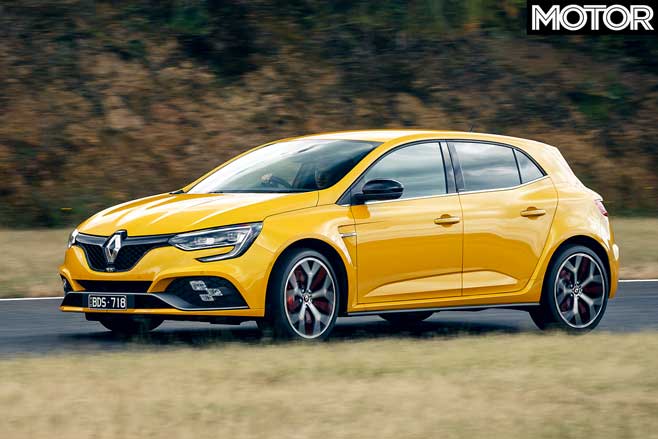
Traction control smooths out the Renault’s strong mid-range in first gear, but when the taps open the front tyres start to struggle. Quick, efficient shifts keep traction decent and reap a 5.83sec 0-100km/h time in three attempts, though a relatively tubby kerb weight means the Renault loses a few clicks on trap speed. Still, its 13.89sec 0-400m time with 170.85km/h on board is respectable. Especially considering how easily it’s achieved.
A change of scenery to the Haunted Hills circuit resets the scoreboard. But, while the Renault’s torque-rich engine seems suited to what is more of an undulating motorkhana with kerbs than a traditional racetrack, things play out differently.
Renault has geared the EDC shorter than the manual, which effectively multiplies the applied torque to the front wheels. You therefore have to be careful booting the Trophy EDC out of corners or it feels like it could torque-steer itself out of track limits. Even with dual-axis hubs.
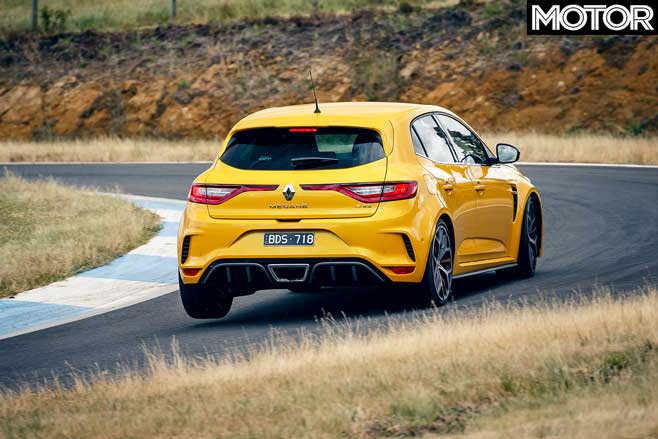
The Trophy is a remarkably precise gadget in other areas though. The steering remains pin-sharp and the off-centre accuracy is sublime. Its firm damping ensures ninja-like reflexes and extracts ridiculous amounts of cornering grip from the Bridgestone rubber.
Then there’s the controversial rear-steer system. We know what it’s meant to do – steer in the opposite direction for agility at lower speeds, and then the same direction for stability at higher speeds – but it’s never clear how much it’s helping.
Luckily, the paddleshifts give your brain some much-needed mental capacity to learn how the system behaves. It’s not a problem when chucking the Renault into hairpins on three wheels because the suspension’s doing all the work here. It’s more when you’re nudging it through long radius bends and it steers into the bend more than you’re expecting. The trickery conceals the car’s true limits.
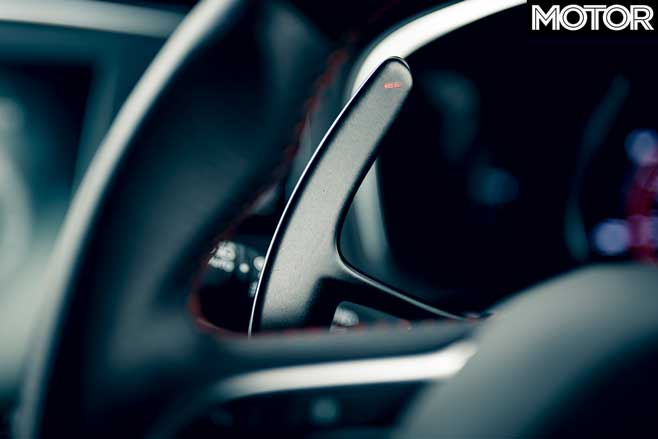
There’s no such mystery with the Hyundai. In fact, its handling characteristics are more of the opposite. Although the controls are nowhere near as positive as the Renault’s at low speeds, since the steering is heavier and the pedals are softer, they come alive with feedback when you start to push on. It all feels set up to give you as much information as possible. The brakes are solid too.
Push the Hyundai to its limit, as it will encourage, and the front Pirellis will chatter in protest when you’ve piled into a corner with too much lock or speed, which is a known characteristic with i30 Ns. But the Fastback’s front-end at least feels like it finds a fraction more grip when you’re setting it up on corner exit. Mash the throttle and that electronic diff will deploy the turbo engine’s generous torque.
The Honda isn’t so well behaved. Give it too much clog with some steering lock and the wheel will try to pull itself straight before you’re out of the corner. But that’s all you can really fault its dynamics for. The moment you nestle into the car’s deep-set pews you can sense how much lower it sits. It feels hunkered down, like the bulk of its weight is far underneath you, and this means you can feel any yaw movements sooner through the seat of your pants.

Yes, the steering is slightly more elastic than the Renault’s, but the dual-pinion set-up is brilliantly responsive and direct. The brakes are firm and powerful, and the gearshift is slick, sharp and positive. The lower centre of gravity, combined with adjustable adaptive damping, also let Honda dial down the roll stiffness in the suspension hardware.
The Type R’s chassis brilliance continues when we break out onto the craggy roads surrounding the track. As we bomb through corners signposted at 100km/h, it’s calm and collected. Potholes pose no problem; you brace for impact but glide over them with suppleness and stability. Its ride and handling mix is almost perfect. We’d only wish you could unlock the dampers from the overall drive-mode system. Or, perhaps, for an edgier exhaust note.
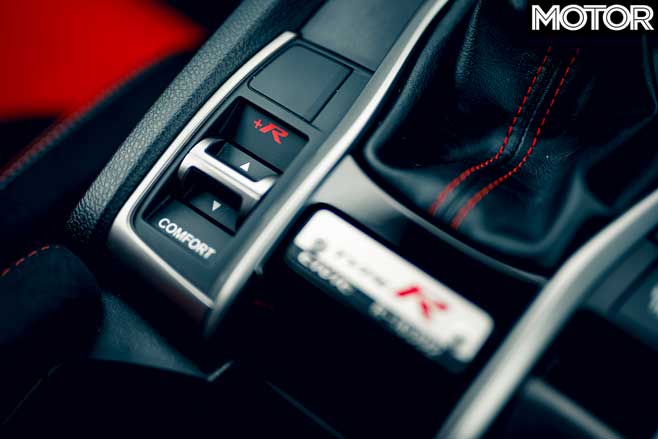
We’d happily settle for something like Renault’s exhaust system, which helps the Megane’s 1.8-litre belt out a gravelly noise while burping explosively on the upshifts. It’s a downright cackle.
But while that’s an assault on the senses, over these pockmarked roads the Trophy can be bit exhausting when you consider everything that’s going on. While the lighter front brake discs calm its sharp ride ever so slightly, you still pogo about in the front seat as the suspension struggles to settle. Sure, the hydraulic bump-stops absorb the worst hits and let you bully the road into submission if you’re up for it, but ultimately the handling experience is just not as enjoyable as it is on track.
The Hyundai, meanwhile, with adaptive damping and independent suspension all round, goes some way to filtering out large frequency bumps. But corrugated surfaces and big lumps expose the limits of its ride comfort. Ultimately, since there is an evident compromise, it sacrifices comfort for ultimate control.
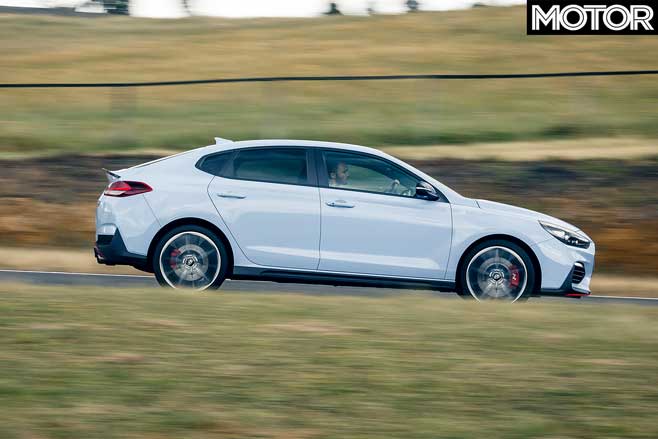
Still, the Hyundai feels cohesive no matter what mode combination you choose for its components. On the open road we settle on: sport diff, normal damping, normal steering and Sport Plus engine tune. And the exhaust is always set to its loudest mode in hope the Honda might imitate it. But more often the Hyundai is outshone here.
There’s still plenty to like about the Fastback N. It’s an accessible performance car with enough character and talent to entertain you on road and track, just like the hatch. It’s not that compromised either, since luggage space is actually greater than with the hatch as well.
But does it improve the core package? Not really. At least not to the level of the Honda or the Renault. Maybe we shouldn’t expect it to at this price. The i30 Fastback N is fantastic value, even if its $7K advantage can’t stop us from looking past it for the Honda.
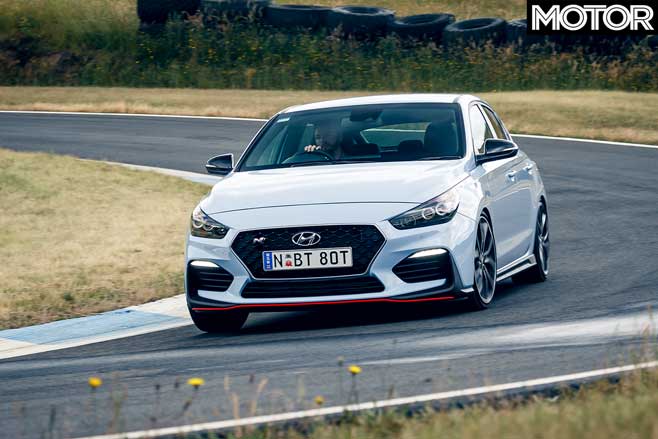
The Civic Type R is so accomplished we’re lucky Honda doesn’t charge more for the pleasure. Yes, it has flaws, but you forget them by simply driving it, at any speed. For instance, the cosseting ride comfort and great front seats have a way of helping it feel more premium than its interior and finicky infotainment program suggest. Two years on from its PCOTY win, it still blows us away with how fast, involving and friendly it is. Do whatever you need to drive one. From its shift and power delivery to its grip and poise, it’s a hot hatch masterclass and a clear winner.
That leaves the Megane RS to grapple with the Fastback N for second place. Don’t get us wrong, the Trophy is a capable car with stupendous grip and quick reflexes. Those Alcantara seats are a nice place to sit too, especially with the Bose stereo cranked up. The EDC gearbox might cost more than a manual, but it’s worth every penny for the added aural drama and more resolved ergonomics.
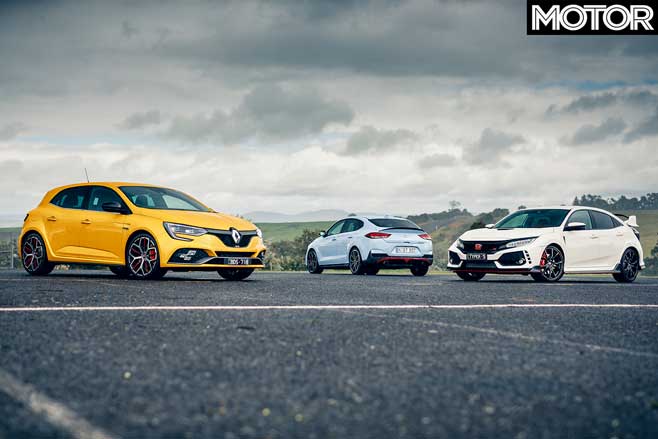
Unfortunately, the car’s overall package isn’t as cohesive or as communicative at its limit as we’d hope. And since that’s what you would expect from a chassis this firm, we’re going to blame the rear-wheel steering. If it was our money – and a choice between a Megane and the Hyundai – then the cheaper Megane RS Cup, with the same chassis but 205kW/390Nm, would be a more attractive alternative.
So the Honda finishes first, Hyundai second and Renault comes in a very close third. We know it’s hardly a shock result, but there’s every chance it might change soon. Honda has confirmed a tweaked Civic Type R is on the way, with new brakes and suspension settings, Renault HQ has reshuffled the Megane RS range around, making the Trophy more exclusive, and Hyundai is due to transfer the Fastback’s suspension settings to the i30 N hatch. Stay tuned.
Fast Facts
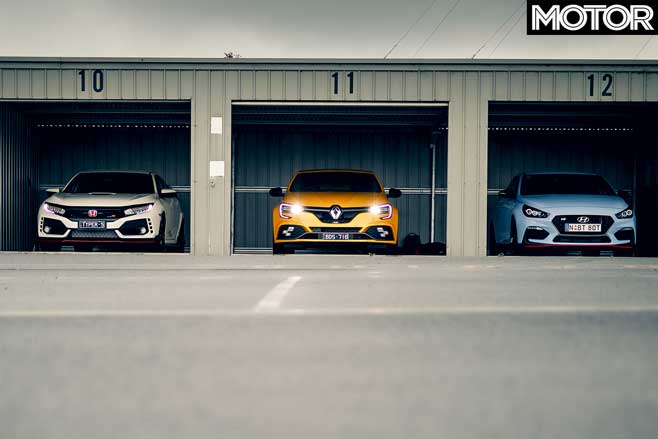
| u00a0 | Honda Civic Type R | Renault Megane RS Trophy 300 | Hyundai i30 Fastback N |
| Body | 5-door, 4-seat hatch | 5-door, 5-seat hatch | |
| Drive | front-wheel | ||
| Engine | 1996cc inline-4, DOHC, 16v, turbo | 1798cc inline-4, DOHC, 16v, turbo | 1998cc inline-4, DOHC, 16v, turbo |
| Bore x Stroke | 86.0 x 85.9mm | 79.7 x 90.1mm | 86.0 x 86.0mm |
| Compression | 9.8:1 | 9.9:1 | 9.5:1 |
| Power | 228kW @ 6500rpm | 221kW @ 6000rpm | 202kW @ 6000rpm |
| Torque | 400Nm @ 2500-4500rpm | 420Nm @ 2400-4800rpm | 353Nm @ 1450-4700rpm (378Nm on overboost) |
| Power/Weight | 164kW/tonne | 145kW/tonne | 141kW/tonne |
| Transmission | 6-speed manual | 6-speed dual-clutch | 6-speed manual |
| Weight | 1393kg | 1452kg | 1441kg |
| Suspension (f) | struts, coils, adaptive dampers, anti-roll bar | struts, coil springs, anti-roll bar | struts, coils, adaptive dampers, anti-roll bar |
| Suspension (r) | multi-links, coils, adaptive dampers, anti-roll bar | torsion beam, coil springs, anti-roll bar | multi-links, coils, adaptive dampers, anti-roll bar |
| L/W/h | 4557/1877/1421mm | 4364/1875/1428mm | 4335/1795/1447mm |
| Wheelbase | 2700mm | 2669mm | 2650mm |
| Tracks | 1599/1593mm (f/r) | 1615/1596mm (f/r) | 1556/1564mm (f/r) |
| Steering | electrically assisted rack-and-pinion | electrically assisted rack-and-pinion, rear-wheel steer | electrically assisted rack-and-pinion |
| Brakes (f) | 350mm ventilated/drilled discs, 4-piston calipers | 355mm ventilated discs, 4-piston calipers | 345mm ventilated discs, 4-piston calipers |
| Brakes (r) | 305mm solid discs, single-piston calipers | 290mm solid discs, single-piston calipers | 314mm ventilated discs, single-piston calipers |
| Wheels | 20.0 x 8.5-inch (f/r) | 19.0 x 9.0-inch (f/r) | 19.0 x 8.0-inch (f/r) |
| Tyre Sizes | 245/30 R20 (f/r) | 245/35 R19 (f/r) | 235/35 R19 (f/r) |
| Tyres | Continental SportContact6 | Bridgestone S001 | Pirelli P Zero |
| Price | $51,990 ($52,565 as tested) | $55,990 | $41,990 ($44,990 as tested) |
| Pros | Sublime handling; slick gearshift; unbelievable ride quality; strong engine delivery; front seats | Huge grip; steering weight; strong engine; full-fruit appeal; musical shifts; soon-to-be exclusive chassis | Mid-range grunt; hilarious WRC-spec exhaust bangs/pops; customisable hardware; engaging chassis |
| Cons | Tacky styling; infotainment; rubbery steering weight; torque steer | Unnatural rear steering; stiff ride; no optional wheel/tyre pack; the new one is more powerful; torque-steer | Low cornering limits; understeer; notchy shift; awkward looks |
| Rating | 4.5 out of 5 stars | 3.5 out of 5 stars | 4 out of 5 stars |
The Strip

| u00a0 | Honda Civic Type R | Renault Megane RS Trophy 300 | Hyundai i30 Fastback N |
| 0-10km/h | 0.44sec | 0.55sec | 0.42sec |
| 0-20km/h | 0.94sec | 1.10sec | 0.93sec |
| 0-30km/h | 1.42sec | 1.65sec | 1.45sec |
| 0-40km/h | 1.91sec | 2.14sec | 1.93sec |
| 0-50km/h | 2.62sec | 2.68sec | 2.43sec |
| 0-60km/h | 3.11sec | 3.21sec | 3.18sec |
| 0-70km/h | 3.64sec | 3.76sec | 3.79sec |
| 0-80km/h | 4.21sec | 4.34sec | 4.43sec |
| 0-90km/h | 4.80sec | 5.00sec | 5.12sec |
| 0-100km/h | 5.81sec | 5.83sec | u00a06.22sec |
| 0-110km/h | 6.57sec | 6.61sec | 7.25sec |
| 0-120km/h | 7.39sec | 7.45sec | 8.26sec |
| 0-130km/h | 8.28sec | 8.45sec | 9.32sec |
| 0-140km/h | 9.61sec | 9.61sec | 10.58sec |
| 0-150km/h | 10.75sec | 10.80sec | 12.34sec |
| 0-160km/h | 11.99sec | 12.18sec | 13.88sec |
| 0-170km/h | 13.40sec | 13.77sec | n/a |
| 0-400m | 13.77sec @ 172.38km/h | 13.89sec @ 170.85km/h | 14.28@ 162.51km/h |
| 80-120km/h | 3.18sec | 3.10sec | 3.83 |
| 100-0km/h | 35.8m | 36.23m | 40.3m |
| Speed in Gears | |||
| 1st | 58km/h @ 7000rpm | 59km/h @ 6875rpm | 62km/h @ 6750rpm |
| 2nd | 99km/h @ 7000rpm | 94km/h @u00a06875rpm | 98km/h @ 6750rpm |
| 3rd | 137km/h @ 7000rpm | 136km/h @u00a06875rpm | 149km/h @ 6750rpm |
| 4th | 187km/h @ 7000rpm | 186km/h @u00a06875rpm | 199km/h @ 6750rpm |
| 5th | 231km/h @ 7000rpm* | 242km/h @ 6875rpm* | 247km/h @ 6750rpm* |
| 6th | 272km/h @ 6650rpm* | 265km/h @ 6165rpm* | 250km/h @ 5700rpm* |
Heathcote Raceway, 20.0˚C, dry. Driver: Louis Cordony/Scott Newman *Manufacturer’s claim Official timing supplier: www.vboxaustralia.com.au


